Finite-Time Stabilization Criteria of Delayed Inertial Neural Networks with Settling-Time Estimation Protocol and Reliable Control Mechanism
Abstract
1. Introduction
- By combining a novel NROD with FTS theorems, we create a new approach, which is entirely different from the existing variable transformation approach, and low-order INNs are used to develop novel FTS criteria to ensure the stabilization of the discussed INNs in finite time.
- In contrast to several earlier works, a wider range of settling-time estimation mechanisms is analyzed.
2. Preliminaries
3. Main Results
4. Illustrative Examples
5. Conclusions
Author Contributions
Funding
Data Availability Statement
Conflicts of Interest
References
- Lakshmanan, S.; Prakash, M.; Lim, C.P.; Rakkiyappan, R.; Balasubramaniam, P.; Nahavandi, S. Synchronization of an Inertial Neural Network With Time-Varying Delays and Its Application to Secure Communication. IEEE Trans. Neural Netw. Learn. Syst. 2018, 29, 195–207. [Google Scholar] [CrossRef]
- Prakash, M.; Balasubramaniam, P.; Lakshmanan, S. Synchronization of Markovian jumping inertial neural networks and its applications in image encryption. Neural Netw. 2016, 83, 86–93. [Google Scholar] [CrossRef]
- Babcock, K.; Westervelt, R. Stability and dynamics of simple electronic neural networks with added inertia. Phys. D Nonlinear Phenom. 1986, 23, 464–469. [Google Scholar] [CrossRef]
- Angelaki, D.E.; Correia, M.J. Models of membrane resonance in pigeon semicircular canal type II hair cells. Biol. Cybern. 1991, 65, 1–10. [Google Scholar] [CrossRef] [PubMed]
- Babcock, K.; Westervelt, R. Dynamics of simple electronic neural networks. Phys. D Nonlinear Phenom. 1987, 28, 305–316. [Google Scholar] [CrossRef]
- Wheeler, D.W.; Schieve, W. Stability and chaos in an inertial two-neuron system. Phys. D Nonlinear Phenom. 1997, 105, 267–284. [Google Scholar] [CrossRef]
- Shi, J.; Zeng, Z. Global exponential stabilization and lag synchronization control of inertial neural networks with time delays. Neural Netw. 2020, 126, 11–20. [Google Scholar] [CrossRef]
- Li, N.; Zheng, W.X. Synchronization criteria for inertial memristor-based neural networks with linear coupling. Neural Netw. 2018, 106, 260–270. [Google Scholar] [CrossRef]
- Hua, L.; Zhu, H.; Shi, K.; Zhong, S.; Tang, Y.; Liu, Y. Novel Finite-Time Reliable Control Design for Memristor-Based Inertial Neural Networks With Mixed Time-Varying Delays. IEEE Trans. Circuits Syst. I Regul. Pap. 2021, 68, 1599–1609. [Google Scholar] [CrossRef]
- Zhang, G.; Hu, J.; Zeng, Z. New Criteria on Global Stabilization of Delayed Memristive Neural Networks With Inertial Item. IEEE Trans. Cybern. 2020, 50, 2770–2780. [Google Scholar] [CrossRef]
- Zhang, G.; Zeng, Z.; Hu, J. New results on global exponential dissipativity analysis of memristive inertial neural networks with distributed time-varying delays. Neural Netw. 2018, 97, 183–191. [Google Scholar] [CrossRef] [PubMed]
- Aouiti, C. Oscillation of impulsive neutral delay generalized high-order Hopfield neural networks. Neural Comput. Appl. 2018, 29, 477–495. [Google Scholar] [CrossRef]
- Arbi, A.; Cao, J.; Alsaedi, A. Improved synchronization analysis of competitive neural networks with time-varying delays. Nonlinear Anal. Model. Control 2018, 23, 82–102. [Google Scholar] [CrossRef]
- Dong, S.; Zhong, S.; Shi, K.; Kang, W.; Cheng, J. Further improved results on non-fragile H∞ performance state estimation for delayed static neural networks. Neurocomputing 2019, 356, 9–20. [Google Scholar] [CrossRef]
- Gunasekaran, N.; Thoiyab, N.M.; Muruganantham, P.; Rajchakit, G.; Unyong, B. Novel Results on Global Robust Stability Analysis for Dynamical Delayed Neural Networks Under Parameter Uncertainties. IEEE Access 2020, 8, 178108–178116. [Google Scholar] [CrossRef]
- Phat, V.N.; Trinh, H. Exponential stabilization of neural networks with various activation functions and mixed time-varying delays. IEEE Trans. Neural Netw. 2010, 21, 1180–1184. [Google Scholar] [CrossRef]
- Aouiti, C.; Coirault, P.; Miaadi, F.; Moulay, E. Finite time boundedness of neutral high-order Hopfield neural networks with time delay in the leakage term and mixed time delays. Neurocomputing 2017, 260, 378–392. [Google Scholar] [CrossRef]
- Wang, Q.; Perc, M.; Duan, Z.; Chen, G. Impact of delays and rewiring on the dynamics of small-world neuronal networks with two types of coupling. Phys. A Stat. Mech. Appl. 2010, 389, 3299–3306. [Google Scholar] [CrossRef]
- Wang, Q.; Chen, G.; Perc, M. Synchronous Bursts on Scale-Free Neuronal Networks with Attractive and Repulsive Coupling. PLoS ONE 2011, 6, e15851. [Google Scholar] [CrossRef] [PubMed]
- Guo, D.; Wang, Q.; Perc, M. Complex synchronous behavior in interneuronal networks with delayed inhibitory and fast electrical synapses. Phys. Rev. E 2012, 85, 061905. [Google Scholar] [CrossRef]
- Zhang, R.; Park, J.H.; Zeng, D.; Liu, Y.; Zhong, S. A new method for exponential synchronization of memristive recurrent neural networks. Inf. Sci. 2018, 466, 152–169. [Google Scholar] [CrossRef]
- Ali, M.S.; Hymavathi, M.; Rajchakit, G.; Saroha, S.; Palanisamy, L.; Hammachukiattikul, P. Synchronization of Fractional Order Fuzzy BAM Neural Networks With Time Varying Delays and Reaction Diffusion Terms. IEEE Access 2020, 8, 186551–186571. [Google Scholar] [CrossRef]
- Yang, D.; Zong, G.; Nguang, S.K. H∞ bumpless transfer reliable control of Markovian switching LPV systems subject to actuator failures. Inf. Sci. 2020, 512, 431–445. [Google Scholar] [CrossRef]
- Zeng, D.; Zhang, R.; Park, J.H.; Zhong, S.; Cheng, J.; Wu, G.C. Reliable stability and stabilizability for complex-valued memristive neural networks with actuator failures and aperiodic event-triggered sampled-data control. Nonlinear Anal. Hybrid Syst. 2021, 39, 100977. [Google Scholar] [CrossRef]
- Ye, D.; Su, L.; Wang, J.; Pan, Y. Adaptive Reliable H∞ Optimization Control for Linear Systems With Time-Varying Actuator Fault and Delays. IEEE Trans. Syst. Man Cybern. Syst. 2017, 47, 1635–1643. [Google Scholar] [CrossRef]
- Yu, X.; Pan, H.; Sun, W.; Gao, H. Reliable Control for a Class of Nonlinear Time-Delay Systems Against Actuator Faults With Application to Suspension Control. IEEE/ASME Trans. Mechatron. 2019, 24, 2498–2507. [Google Scholar] [CrossRef]
- Xiao, Q.; Huang, T.; Zeng, Z. Global Exponential Stability and Synchronization for Discrete-Time Inertial Neural Networks With Time Delays: A Timescale Approach. IEEE Trans. Neural Netw. Learn. Syst. 2019, 30, 1854–1866. [Google Scholar] [CrossRef]
- Sheng, Y.; Huang, T.; Zeng, Z.; Li, P. Exponential Stabilization of Inertial Memristive Neural Networks With Multiple Time Delays. IEEE Trans. Cybern. 2021, 51, 579–588. [Google Scholar] [CrossRef]
- Zhang, G.; Zeng, Z. Stabilization of Second-Order Memristive Neural Networks With Mixed Time Delays via Nonreduced Order. IEEE Trans. Neural Netw. Learn. Syst. 2020, 31, 700–706. [Google Scholar] [CrossRef]
- Xiong, X.; Yang, X.; Cao, J.; Tang, R. Finite-time control for a class of hybrid systems via quantized intermittent control. Sci. China Inf. Sci. 2020, 63, 1–16. [Google Scholar] [CrossRef]
- Ding, Z.; Zeng, Z.; Wang, L. Robust finite-time stabilization of fractional-order neural networks with discontinuous and continuous activation functions under uncertainty. IEEE Trans. Neural Netw. Learn. Syst. 2017, 29, 1477–1490. [Google Scholar] [CrossRef] [PubMed]
- Hu, T.; He, Z.; Zhang, X.; Zhong, S. Finite-time stability for fractional-order complex-valued neural networks with time delay. Appl. Math. Comput. 2020, 365, 124715. [Google Scholar] [CrossRef]
- Sun, Z.; Zhou, C.; Chen, C.C.; Meng, Q. Fast finite-time adaptive stabilization of high-order uncertain nonlinear systems with output constraint and zero dynamics. Inf. Sci. 2020, 514, 571–586. [Google Scholar] [CrossRef]
- Hua, L.; Zhong, S.; Shi, K.; Zhang, X. Further results on finite-time synchronization of delayed inertial memristive neural networks via a novel analysis method. Neural Netw. 2020, 127, 47–57. [Google Scholar] [CrossRef] [PubMed]
- Ren, H.; Zong, G.; Karimi, H.R. Asynchronous Finite-Time Filtering of Networked Switched Systems and its Application: An Event-Driven Method. IEEE Trans. Circuits Syst. I Regul. Pap. 2019, 66, 391–402. [Google Scholar] [CrossRef]
- Zong, G.; Ren, H.; Karimi, H.R. Event-triggered communication and annular finite-time H∞ filtering for networked switched systems. IEEE Trans. Cybern. 2020, 51, 309–317. [Google Scholar] [CrossRef]
- Zhou, Y.; Wan, X.; Huang, C.; Yang, X. Finite-time stochastic synchronization of dynamic networks with nonlinear coupling strength via quantized intermittent control. Appl. Math. Comput. 2020, 376, 125157. [Google Scholar] [CrossRef]
- Shi, K.; Wang, J.; Zhong, S.; Tang, Y.; Cheng, J. Non-fragile memory filtering of T-S fuzzy delayed neural networks based on switched fuzzy sampled-data control. Fuzzy Sets Syst. 2020, 394, 40–64. [Google Scholar] [CrossRef]
- Cheng, J.; Huang, W.; Park, J.H.; Cao, J. A Hierarchical Structure Approach to Finite-Time Filter Design for Fuzzy Markov Switching Systems With Deception Attacks. IEEE Trans. Cybern. 2022, 52, 7254–7264. [Google Scholar] [CrossRef]
- Gong, S.; Yang, S.; Guo, Z.; Huang, T. Global exponential synchronization of inertial memristive neural networks with time-varying delay via nonlinear controller. Neural Netw. 2018, 102, 138–148. [Google Scholar] [CrossRef]
- Wang, L.; Zeng, Z.; Ge, M.; Hu, J. Global stabilization analysis of inertial memristive recurrent neural networks with discrete and distributed delays. Neural Netw. 2018, 105, 65–74. [Google Scholar] [CrossRef] [PubMed]
- Hua, L.; Zhu, H.; Zhong, S.; Zhang, Y.; Shi, K.; Kwon, O.M. Fixed-Time Stability of Nonlinear Impulsive Systems and Its Application to Inertial Neural Networks. IEEE Trans. Neural Netw. Learn. Syst. 2022, 1–12. [Google Scholar] [CrossRef]
- Wei, R.; Cao, J.; Abdel-Aty, M. Fixed-Time Synchronization of Second-Order MNNs in Quaternion Field. IEEE Trans. Syst. Man, Cybern. Syst. 2019, 51, 3587–3598. [Google Scholar] [CrossRef]
- Xiao, Q.; Huang, Z.; Zeng, Z. Passivity Analysis for Memristor-Based Inertial Neural Networks With Discrete and Distributed Delays. IEEE Trans. Syst. Man Cybern. Syst. 2019, 49, 375–385. [Google Scholar] [CrossRef]
- Chen, C.; Li, L.; Peng, H.; Yang, Y. Fixed-time synchronization of inertial memristor-based neural networks with discrete delay. Neural Netw. 2019, 109, 81–89. [Google Scholar] [CrossRef]
- Xiao, Q.; Huang, T.; Zeng, Z. Passivity and Passification of Fuzzy Memristive Inertial Neural Networks on Time Scales. IEEE Trans. Fuzzy Syst. 2018, 26, 3342–3355. [Google Scholar] [CrossRef]
- Zhang, G.; Zeng, Z.; Ning, D. Novel results on synchronization for a class of switched inertial neural networks with distributed delays. Inf. Sci. 2020, 511, 114–126. [Google Scholar] [CrossRef]
- Tang, Y. Terminal sliding mode control for rigid robots. Automatica 1998, 34, 51–56. [Google Scholar] [CrossRef]
- Shen, Y.; Huang, Y. Uniformly Observable and Globally Lipschitzian Nonlinear Systems Admit Global Finite-Time Observers. IEEE Trans. Autom. Control 2009, 54, 2621–2625. [Google Scholar] [CrossRef]
- Forti, M.; Grazzini, M.; Nistri, P.; Pancioni, L. Generalized Lyapunov approach for convergence of neural networks with discontinuous or non-Lipschitz activations. Phys. D Nonlinear Phenom. 2006, 214, 88–99. [Google Scholar] [CrossRef]
- Filippov, A.F. Differential Equations with Discontinuous Right-Hand Sides; Kluwer: Dordrecht, The Netherlands, 1988. [Google Scholar]
- Sathishkumar, M.; Liu, Y.C. Resilient annular finite-time bounded and adaptive event-triggered control for networked switched systems with deception attacks. IEEE Access 2021, 9, 92288–92299. [Google Scholar] [CrossRef]
- Humphries, U.; Rajchakit, G.; Kaewmesri, P.; Chanthorn, P.; Sriraman, R.; Samidurai, R.; Lim, C.P. Global Stability Analysis of Fractional-Order Quaternion-Valued Bidirectional Associative Memory Neural Networks. Mathematics 2020, 8, 801. [Google Scholar] [CrossRef]
- Shi, K.; Wang, J.; Tang, Y.; Zhong, S. Reliable asynchronous sampled-data filtering of T-S fuzzy uncertain delayed neural networks with stochastic switched topologies. Fuzzy Sets Syst. 2020, 381, 1–25. [Google Scholar] [CrossRef]
- Zhang, Y.; Feng, Z.G.; Yang, X.; Alsaadi, F.E.; Ahmad, B. Finite-time stabilization for a class of nonlinear systems via optimal control. Math. Comput. Simul. 2018, 146, 14–26. [Google Scholar] [CrossRef]
- Yang, X.; Cao, J.; Xu, C.; Feng, J. Finite-time stabilization of switched dynamical networks with quantized couplings via quantized controller. Sci. China Technol. Sci. 2018, 61, 299–308. [Google Scholar] [CrossRef]
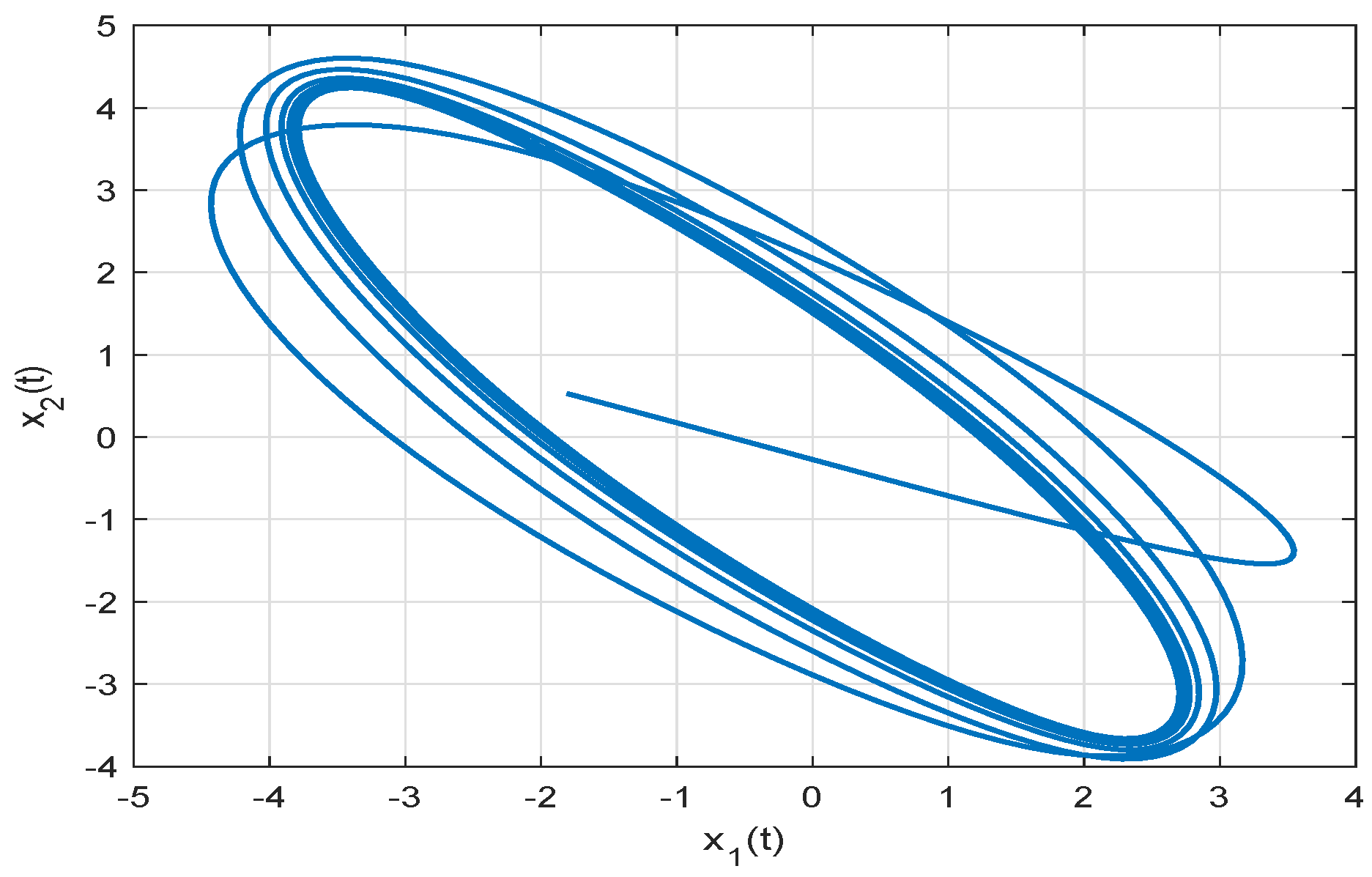
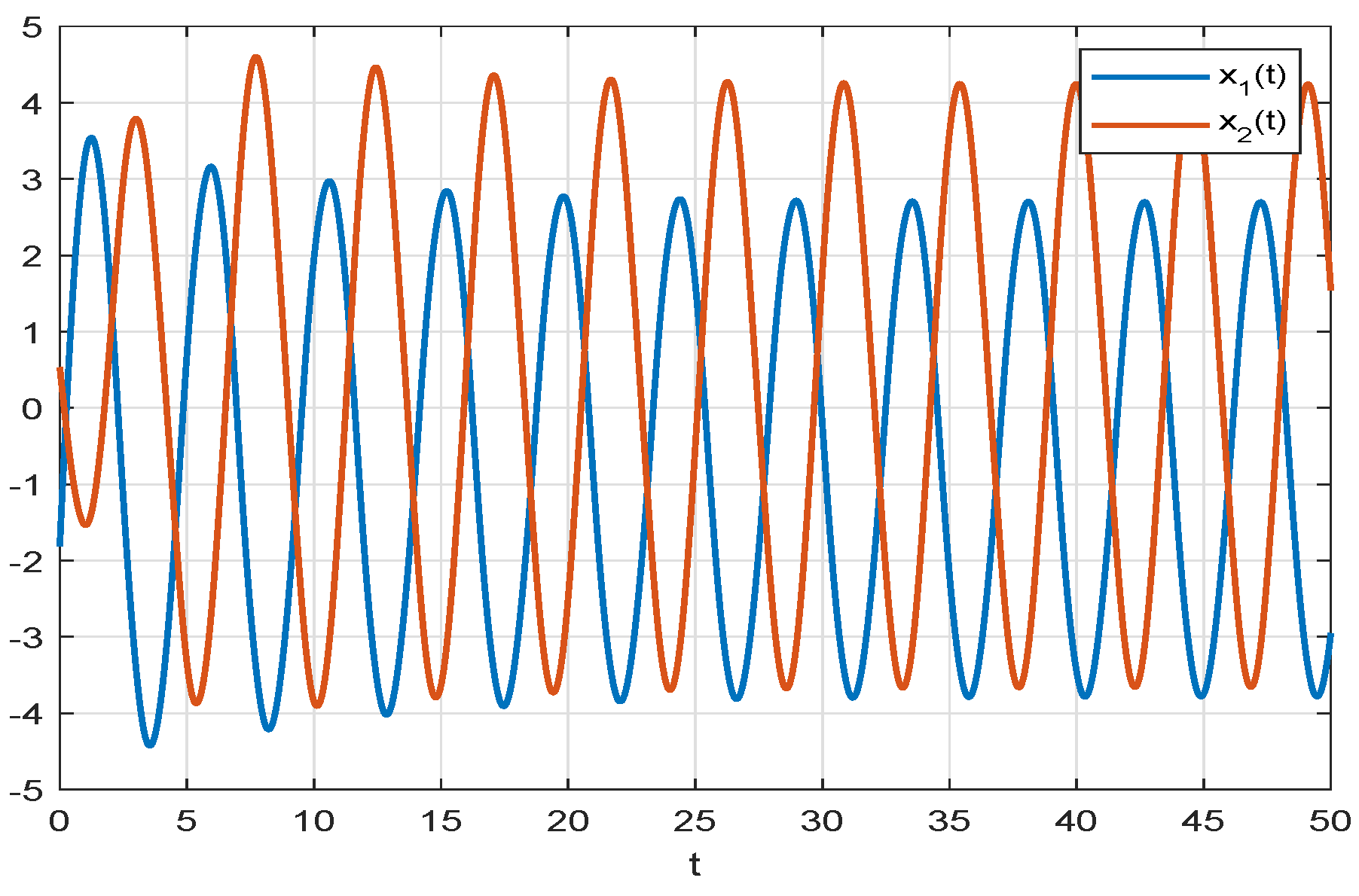
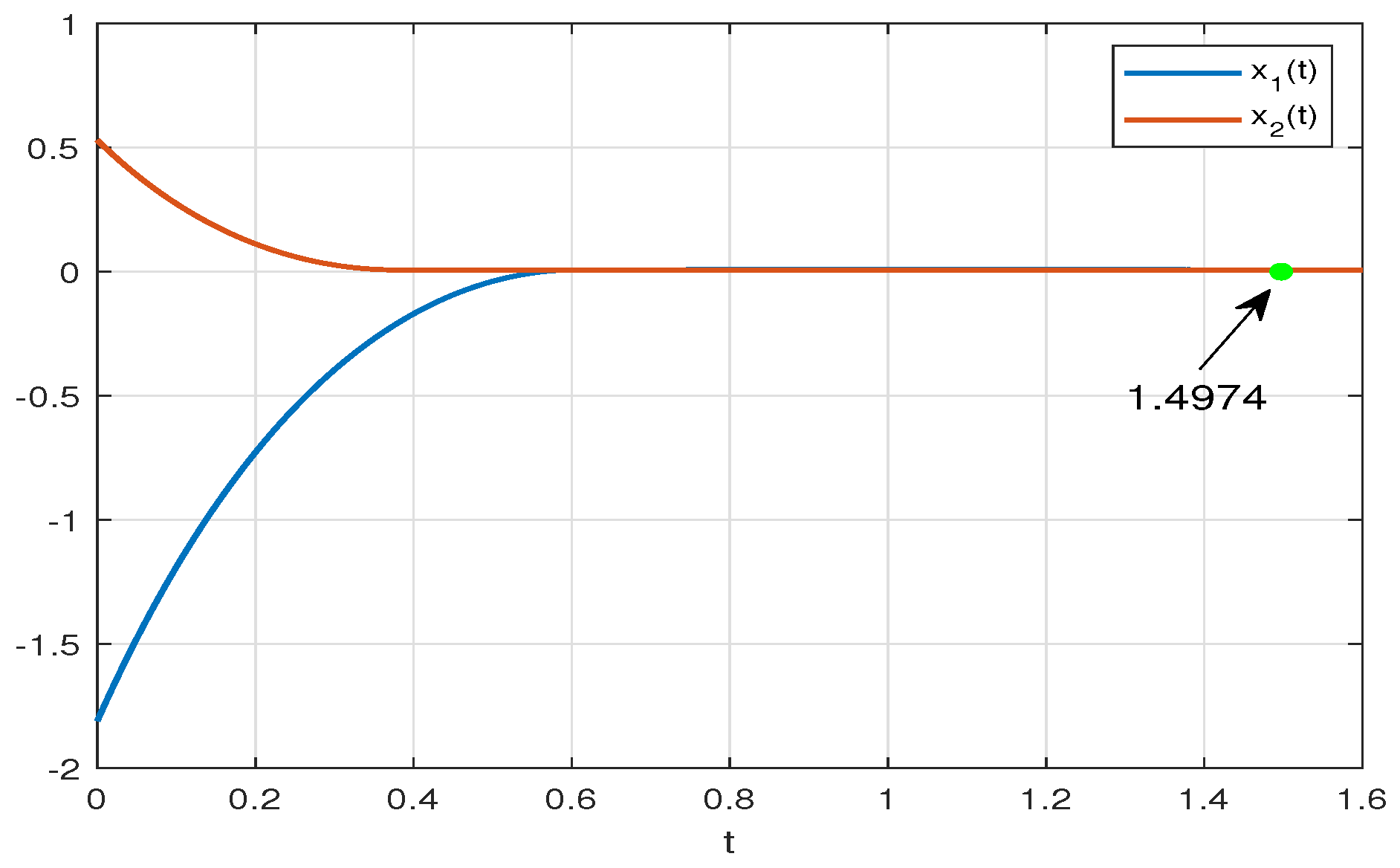
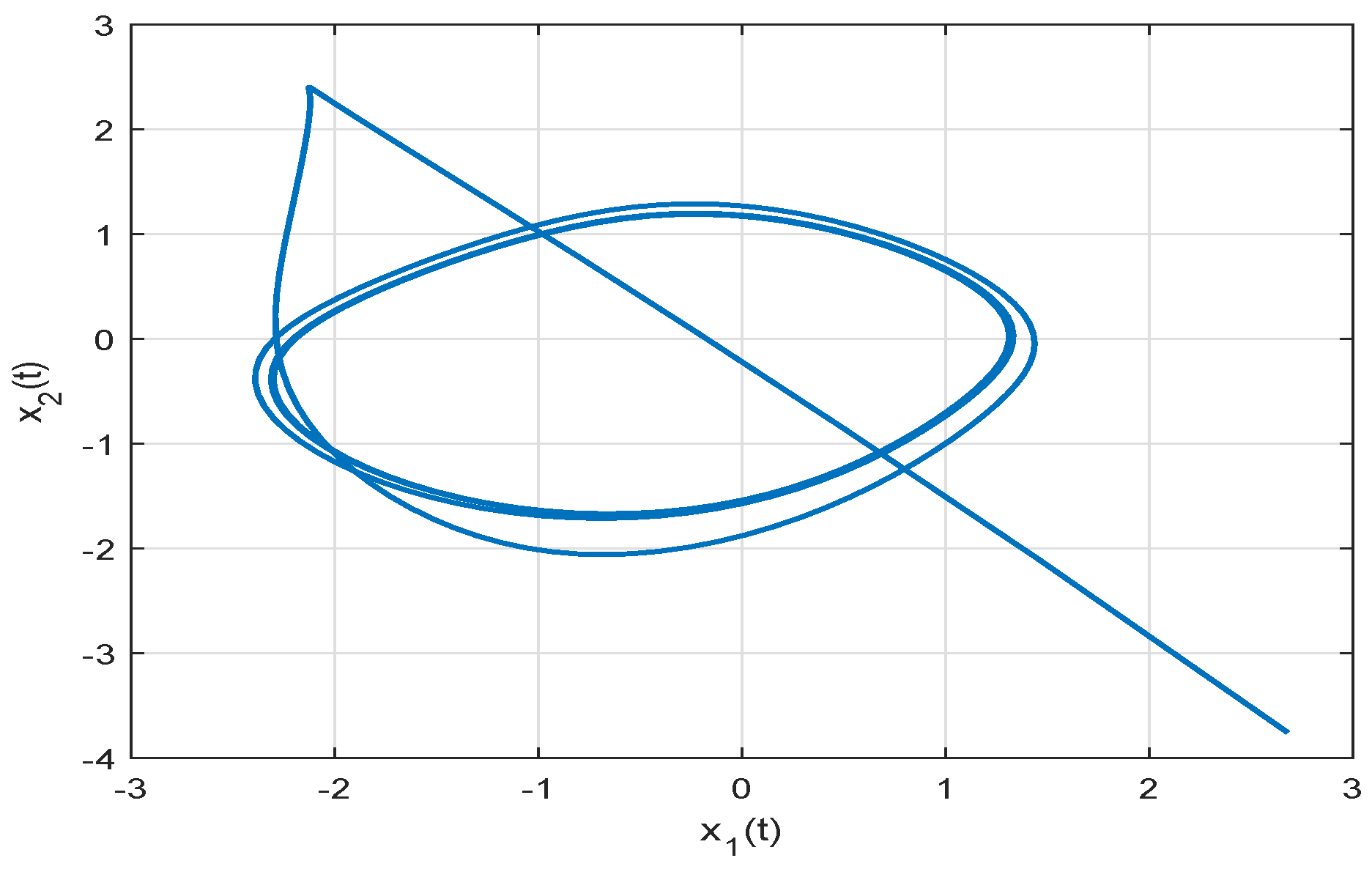
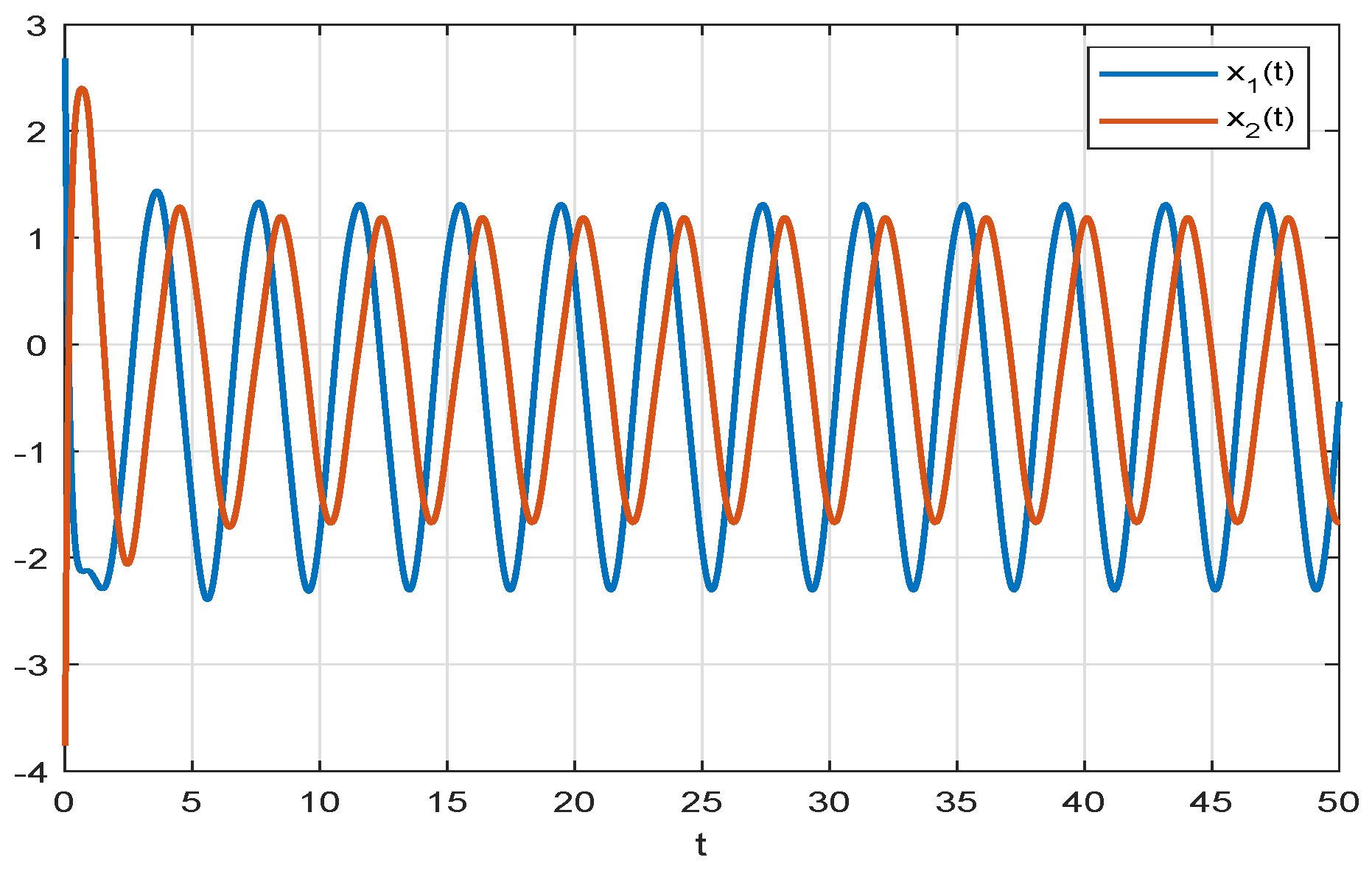

Disclaimer/Publisher’s Note: The statements, opinions and data contained in all publications are solely those of the individual author(s) and contributor(s) and not of MDPI and/or the editor(s). MDPI and/or the editor(s) disclaim responsibility for any injury to people or property resulting from any ideas, methods, instructions or products referred to in the content. |
© 2023 by the authors. Licensee MDPI, Basel, Switzerland. This article is an open access article distributed under the terms and conditions of the Creative Commons Attribution (CC BY) license (https://creativecommons.org/licenses/by/4.0/).
Share and Cite
Wang, W.; Hua, L.; Zhu, H.; Wang, J.; Shi, K.; Zhong, S. Finite-Time Stabilization Criteria of Delayed Inertial Neural Networks with Settling-Time Estimation Protocol and Reliable Control Mechanism. Fractal Fract. 2023, 7, 114. https://doi.org/10.3390/fractalfract7020114
Wang W, Hua L, Zhu H, Wang J, Shi K, Zhong S. Finite-Time Stabilization Criteria of Delayed Inertial Neural Networks with Settling-Time Estimation Protocol and Reliable Control Mechanism. Fractal and Fractional. 2023; 7(2):114. https://doi.org/10.3390/fractalfract7020114
Chicago/Turabian StyleWang, Wenhao, Lanfeng Hua, Hong Zhu, Jun Wang, Kaibo Shi, and Shouming Zhong. 2023. "Finite-Time Stabilization Criteria of Delayed Inertial Neural Networks with Settling-Time Estimation Protocol and Reliable Control Mechanism" Fractal and Fractional 7, no. 2: 114. https://doi.org/10.3390/fractalfract7020114
APA StyleWang, W., Hua, L., Zhu, H., Wang, J., Shi, K., & Zhong, S. (2023). Finite-Time Stabilization Criteria of Delayed Inertial Neural Networks with Settling-Time Estimation Protocol and Reliable Control Mechanism. Fractal and Fractional, 7(2), 114. https://doi.org/10.3390/fractalfract7020114






